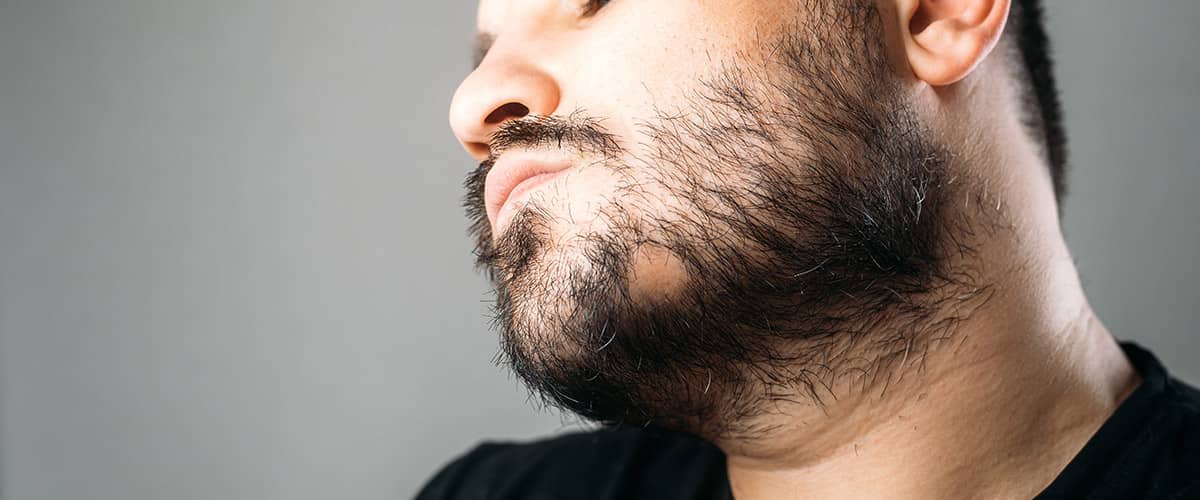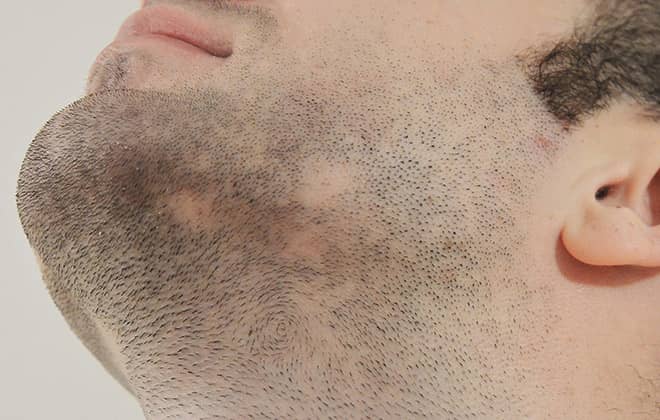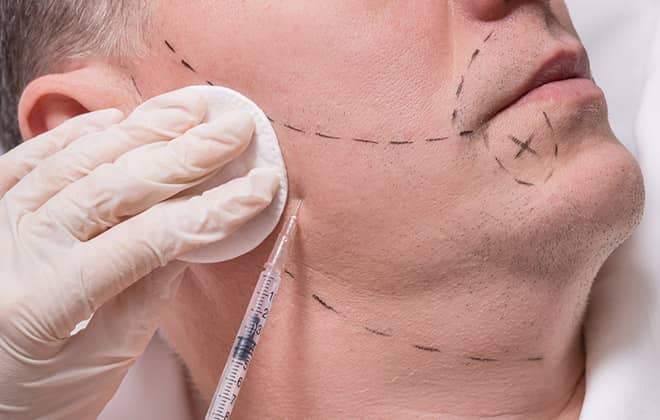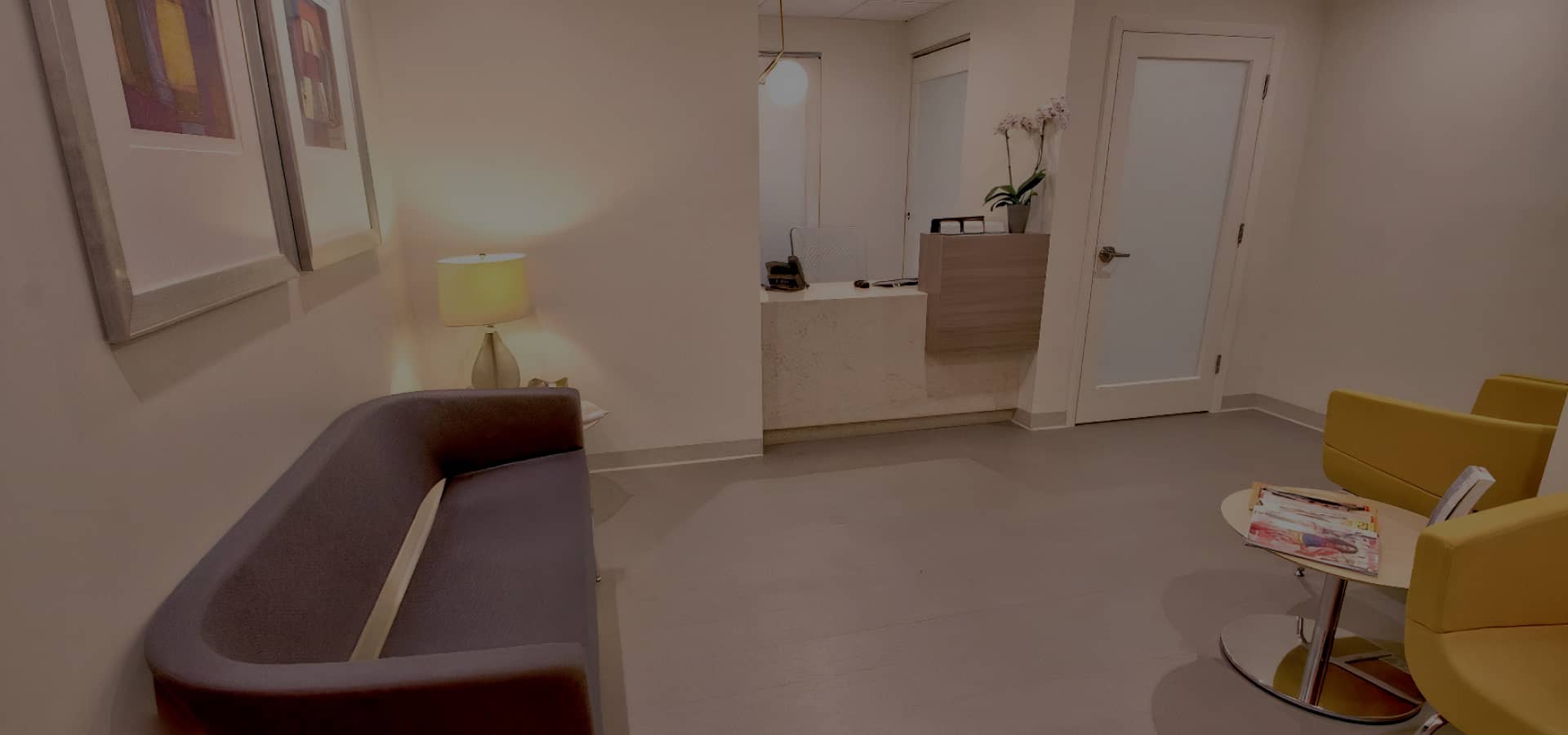Patchy and thin facial hair is a common problem among men, with up to 50% of men reporting that they are disappointed with their beard’s current density and coverage. Fortunately, men who have struggled for years to grow attractive facial hair can now enjoy natural, permanent hair growth with a beard transplant performed by an experienced hair transplant specialist. Beard transplant patients may request sideburns, a long beard, goatee facial hair, mustache, or a short scruffy beard.
The beard transplant procedure is customized to enhance the patient’s appearance and personal requests are welcome. Some men prefer a scruffy or rugged beard, while others want a professional, groomed appearance at all times. Other options may include:
- Coverage of burns and scars caused by a prior injury.
- Creating a natural, permanent beard for FTM transgender men.
- Filling in thin or bare areas in a man’s beard.
The perfect candidate for a Beard Transplant
Ideal beard transplant candidates should have between 2,000 and 2,500 viable hair follicles located in the back area of the scalp, where the hair is typically the thickest and most resistant to hair loss, making it perfect for beard transplantation. They must also have realistic expectations and be willing to follow all aftercare instructions in order to encourage the best results. A hair transplant specialist determines each patient’s candidacy during a private consultation.
A hair transplant specialist performs a beard transplant procedure to fill in a patchy beard or to create sideburns, a goatee, or a full beard. The doctor chooses a donor area on the back or sides of the scalp where the hair matches the coarseness and color of the patient’s beard. The hair is then transferred from the donor area to the beard using FUT or FUE technology, which provides natural-looking, permanent results.

Dr. Bared explains who makes a good candidate for beard transplantation
Transgender Beard Transplant Candidates
During the female to male transgender (FTM) transition process, patients often request hair transplantation to add chest and pubic hair or create fuller, more masculine sideburns, goatees, beards, or eyebrows. A plastic surgeon may recommend a beard transplant along with another male cosmetic procedure for FTM transgender men, such as primary or revision rhinoplasty, liposuction of the face and jawline, augmentation or reduction of the jaw and brow, or chin implants.
Most FTM patients travel from out-of-state to see a qualified surgeon who has years of experience serving transgender patients. Virtual consultations are usually the first step in these cases.
Candidates for Scar Revision and Beard Transplant Surgery
Scars caused by a previous surgery or injury can be prominent and unsightly. Individuals who feel self-conscious about their scars may be candidates for scar revision, which reduces the appearance of a scar but won’t completely erase it. Scar revision can allow the individual to feel more comfortable with their appearance and decrease:
- Surface irregularity
- Raised (hypertrophic) scars
- Keloids
- Burn scars
Scar revision surgery does not altogether remove scars but significantly improves the appearance and texture of scarring.
The beard transplant procedure is customized to enhance the patient’s appearance and personal requests are welcome for the surgeon to choose the best transplant technique for you.
The plastic surgeon will explain the expected results during the consultation.Some scars may require multiple procedures, and this is particularly common when steroids are injected into the incision to help with healing. The surgeon may recommend a beard transplant procedure after scar revision surgery to conceal any remaining imperfections. FUE beard transplant technology allows the surgeon to strategically place transplanted hairs to hide small scars in the beard area.
Beard Transplant Candidate Complementary Treatments
A beard transplant provides male patients with outstanding benefits, and the procedure may be performed in conjunction with another cosmetic surgery to achieve enhanced results. Men often request complementary treatments, such as eyebrow transplant. Candidacy for facial hair transplants and complementary procedures is determined during the consultation based on the patient’s health and cosmetic goals.
Eyebrow Restoration
Eyebrow restoration is a routine procedure that is commonly performed with a beard transplant. Men often lose the lateral area of the eyebrow due to age or desire a thicker brow for cosmetic reasons.
Men may bring photos to the consultation as examples of the eyebrows they want or may use eyeliner to fill in the brow as they explain the look they wish to achieve. Patients are actively involved in designing their brows and beards to ensure they receive the results they want.
Beard Transplant Candidates Benefit from PRP Growth Therapy
Beard transplant candidates requesting fuller, natural facial hair may benefit from platelet-rich plasma (PRP) growth therapy. PRP is commonly performed as a stand-alone treatment to encourage hair growth and may be completed along with beard transplantation by an experienced hair transplant specialist to improve results and speed healing.
What is Platelet Rich Plasma Therapy?
Platelet-rich plasma therapy after hair transplantation is relatively new. PRP is an evolving treatment that promises to reverse hair loss and improve
is a highly-respected Miami facial plastic surgeon and one of the best beard transplant specialists in the United States, who will surely exceed your expectations.
The PRP hair growth treatment may also be combined with Acell, a regenerative matrix product derived from the porcine bladder, further enhancing hair growth while ensuring purity and safety. Soon, platelet-rich plasma therapy may be considered standard care to be performed with all hair transplant procedures. Surgeons with advanced experience in hair restoration now offer PRP as an add-on service to beard transplant candidates, and the cost of the PRP treatment is applied to the total price of the beard transplant.
PRP treatment offers a 70% to 80% response rate. Improved graft regrowth is experienced when platelet-rich plasma is injected into the scalp or in the grafts’ location, especially for candidates with scarring from an injury or prior transplant and in areas where hair growth is naturally low. The hair transplant specialist may prescribe PRP treatment with a beard transplant for the following benefits:
- Increasing the number of successfully transplanted grafts
- Accelerating healing in the donor and recipient area
- Awakening dormant hairs
- Thickening thin hair
- Slowing active hair loss
- Minimizing scarring when injected into the FUE donor site or FUT/strip
- Encouraging enhanced regrowth of grafts
- Speeding healing
- Improving regrowth of grafts
- Treating hair loss in other areas of the scalp and non-transplanted hairs
Platelet Rich Plasma and Beard Transplant Procedure
When PRP is performed as a standalone treatment, two to four treatments are completed over six months. When PRP is performed with a hair transplant, it is typically conducted once with the hair transplant and repeated six months later. The doctor may recommend bi-yearly treatments to prevent hair loss or thinning on the scalp.
- Local anesthesia is applied to the scalp.
- Blood is drawn from the patient’s arm.
- The blood is spun at high speed in a centrifuge to isolate growth factor proteins and platelets.
- The platelets are extracted using a syringe for injection.
- Acell may be added to the treatment because it encourages regeneration and improves the probability of a positive result.
- The hair transplant is performed, and the PRP growth factor is used to treat hair follicles before implantation before it is injected into the donor area and targeted areas of the beard and scalp to improve the hair transplant results.
Risks associated with PRP combined with a beard transplant are uncommon but may include temporary bruising where blood is drawn, bruising in the donor area caused by injections, or worsened hair loss. Tylenol and similar pain relievers effectively treat minor discomfort and headaches that could occur after the procedure. The hair transplant specialist will discuss the benefits and risks of PRP with the candidate during the beard transplant consultation.
What to Expect at a Beard Transplant Consultation
The beard transplant specialist meets with new patients during a private consultation to determine if they are an ideal candidate for a beard transplant performed using either FUE or FUT technology. The doctor asks the patient to share their goals, examines their scalp to determine if the donor area has an adequate number of healthy hair follicles, and reviews their medical history before deciding if the surgery will provide them with their desired results.
The surgeon will provide the patient with a customized treatment plan if he qualifies as a candidate for a beard transplant procedure. The hair transplant specialist then explains the recovery process and expected results before scheduling the procedure. The office staff will share payment options with the patient and provide them with pre- and post-treatment instructions to ensure the best possible results.
The specialist invites out-of-town patients to schedule a virtual consultation using a video chat app. The patient completes an online health profile and uploads photos. If the patient qualifies as a beard transplant candidate, the doctor explains the customized procedure and the anticipated results, the beard transplant cost, and the recovery.
The patient is invited to schedule a beard transplant procedure and arrives the day before for an in-person exam. Out-of-town patients are typical, and the office staff provides them with travel instructions, hotel recommendations, and engaging local spots to visit.
Beard Transplant Candidates Frequently Asked Questions
Yes, it is safe to travel before and shortly after having a beard transplant performed. Patients typically travel to have a qualified out-of-state beard transplant specialist perform this specialized hair transplant procedure.
It is essential to see an experienced doctor with excellent reviews and photos demonstrating the surgeon’s outstanding results. Men typically arrive the day before the surgery, return for a follow-up visit the next day, and travel home after a brief stay.
The precise number of grafts needed for the beard transplant is based on the patient’s unique goals and existing facial hair. A full beard transplant typically requires 2,500 to 3,000 grafts. The patient may require additional hair grafts for their sideburns and mustache, depending on their personal goals.
Most patients experience short-term side effects, including numbness, mild swelling, tightness, and tiny scabs. Patients must follow the surgeon’s recovery and personal care instructions to ensure proper healing and excellent results.
Ideal beard transplant candidates are transgender female-to-male patients, men with patchy beard growth, and men with burns and small scars from a prior injury who desire a more masculine appearance or a more attractive beard. Men of all races and ethnicities, including Asian and African-American men, seek out beard transplants each year. New patients should ask their surgeon for before and after facial hair transplant pictures Miami.
Want to know more about Beard Transplant?
- Comparing Hair Transplant Results: Dr. Anthony Bared vs. Other Competitors
- Beard Transplant vs. Medical Beard Growth Solutions: What’s Best for You?
- What to Expect Before, During, & After a Beard Transplant
- Surgical Techniques for Beard Implants
- Side Effects of Beard Transplantation
- Beard transplant risks you should be aware of before surgery
- Recovery Process for Facial Hair Transplants
- Beard Growth Medications
- FTM Transgender Beard Transplantation
- Ethnic Patients Facial Hair Restoration
Why Choose Beard Transplant Specialist Dr. Bared in Miami, FL
Dr. Anthony Bared, MD, FACS A plastic surgeon can discuss more permanent and effective options for facial hair restoration, such as a beard transplant, however. Some hair transplant doctors have under-qualified technicians perform the transplant to reduce the cost, which increases the risk of hair transplant failure and infection. Dr. Bared is a highly skilled surgeon who emphasizes the importance of each patient, and he performs each hair transplant surgery himself.
Dr. Bared serves men of every race, nationality, and background, including FTM transgender men, and he is pleased to provide each man with a beard they can proudly display. He serves local and out-of-state patients at his beautiful modern facility at Facial Plastic Surgery in Miami, Florida. Dr. Bared’s many qualifications include:
- A board-certified facial plastic surgeon specializing in facelifts, rhinoplasty, and hair transplants
- Board-certified otolaryngologist (ear, nose, and throat specialist)
- Advanced facial and hair transplant Miami specialist
- FUE and FUT transplant specialist
- Personalized treatment that accommodates patients’ specific requests
- Many years of experience and has performed over 1,000 facial hair transplants.
- Beautiful Miami facility featuring the latest technology
- Each hair transplanted by Dr. Bared has a 90% survival rate.
- Outstanding patient testimonials
Request a Miami Beard Transplant Consultation
Call 305-666-1774 and schedule a virtual or in-person consultation to learn more about facial hair transplant surgery with renowned beard hair transplant Miami specialist Dr. Bared in Florida, or visit Facial Plastic Surgery Miami to schedule your beard transplant consultation online.




